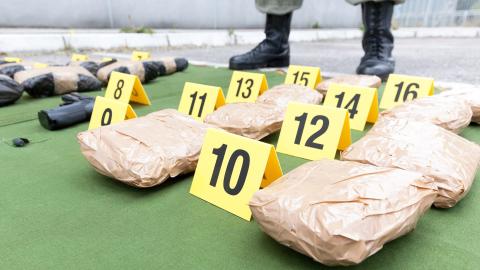The Battle of Dien Bien Phu
War: First Indochina War
Dates: 13th March – 7th May 1954
Place: Dien Bien Phu, Vietnam
Belligerents: France & The State of Vietnam vs Viet Minh
‘You were a kid in the fifties and everybody knows that nothing happened in the fifties.’
These words were said to Billy Joel by a friend of John Lennon’s son Sean, so the 40-year old New Yorker decided to write a song to prove him wrong.
Dien Bien Phu was ‘the only pitched battle to be lost by a European army in the history of decolonisation
In amongst all theperma-famous culture references was the line ‘Dien Bien Phu falls, Rock Around the Clock’ and it’s probably fair to say that this one may have got some people stumped.
In fact, the Battle of Dien Bien Phu is one of the most significant, not just of the 1950s where supposedly nothing much happened, but of the entire 20th century.
In the spring of 1954, eight long and arduous years into the First Indochina War, the French suffered a defeat that was so shameful and shambolic, it remains barely spoken of. Historian Jean-Pierre Rioux said that Dien Bien Phu was ‘the only pitched battle to be lost by a European army in the history of decolonisation’ and it cost the French their Empire. Their century of colonial rule in Indochina – now Vietnam, Laos and Cambodia – was over.
Not long after, the Americans rocked up but that’s for another time.
The prelude to battle
The easternmost country on the Indochina Peninsula, Vietnam has, since the 1500s, been passed from foreign hand to foreign hand. In the sixteenth and early seventeenth centuries, the Portuguese and Dutch had been milling around but both were driven out by the locals and then in 1615, the French arrived.
Their original aim was to spread the word of Christianity and as the 19th century came around, Vietnam’s independence had been gradually eroded until by 1884, the entire country – known then as French Indochina – had come under the rule of France.
During World War II, Japan’s aggression allowed them to take control but the Việt Minh, a national independence coalition led by Hồ Chí Minh, fought the Japanese and by the end of the war had driven them out - only for the French to return and reassert their rule. After many years of foreign subjugation and a burning desire for independence, the Việt Minh started a guerrilla war against the French in 1946. Initially viewed by the French colonial administration as nothing more than a peasant uprising, they were confident of a quick and decisive victory but it proved to be anything but. They were in a proper fight.
After eight years of fighting and with the French strategists propped up by American money, they tried tactic after unsuccessful tactic but eventually ran out of ideas. There was no clear prospect of victory for either side, no long-term vision and fewer and fewer military objectives. They ended up simply defending their positions and reacting to Việt Minh attacks when they occurred. Lessons, it seems, that were not heeded by the Americans as they embarked on their own futile fight in Vietnam later in the decade.
During the first seven years of the war, France had 16 changes of government and 13 prime ministers and not one took any kind of responsibility for strategy, military objective or the colossal failures that ensued. By the start of 1954, it had cost the French and Americans $3 billion – hardly pocket change so soon after World War II – and was referred to as la sale guerre, or ‘the dirty war.’ In addition, accusations of military incompetence, corruption, currency deals and arms trading blighted the war effort.
It was becoming increasingly obvious that this war was unwinnable. The French had lost 75,000 men (with another 65,000 injured and 40,000 taken prisoner) and the Việt Minh lost close to 200,000.
In an effort to bring the war to an end, both sides threw everything into one final and ultimately decisive fight – the Battle of Dien Bien Phu.
A fight, but not how the french envisaged
The town of Dien Bien Phu sits in Vietnam’s north-western corner on the border with Laos. It is a heart-shaped ‘cuvette’, or basin, ringed by jungle-covered hills. In November 1953 General Henri Navarre, commander of French forces in Indochina, ordered the French Expeditionary Force’s parachute battalions to garrison and fortify an old Japanese airstrip – known as Operation Castor – and within weeks it was transformed into a major military base with nine separate camps.
Legend has it that Navarre’s deputy, Colonel Christian de Castries who was supposedly irresistible to women and described by author Grahame Greene as having the ‘nervy histrionic features of an old-time actor’ named the camps after his mistresses: Eliane, Béatrice, Anne-Marie, Gabrielle, Huguette, Claudine, Epervier, Dominique, Francoise and Isabelle.
‘Unstoppable waves’ of 25,000 machine gun-toting Việt Minh infantry engaged the last 3,000 able-bodied French garrison soldiers in brutal hand-to-hand combat
Anyway, the idea was to cut off enemy lines through the mountains into Laos and draw the Việt Minh out into open battle. At the same time Việt Minh commander Võ Nguyên Giáp, widely regarded as one of the 20th century’s finest military strategists, blocked all roads in and out of the town so it became only accessible by air. He also positioned 30 battalions – around 40,000 battle troops – in a ring of steel around the camps, ably supported by a further quarter of a million porters, road gangs and auxiliary soldiers who carried the food, supplies and equipment up the steep slopes.
Describing the scene to journalist Wilfred Burchett, Hồ Chí Minh took off his helmet, turned it upside down and said ‘Down here is the valley of Dien Bien Phu. There are the French. They can’t get out. It may take a long time, but they can’t get out.’
He was right. They were stuck.
As They Walked Through The Shadows of the Valley of Death
On the 13th March the Việt Minh assault began. The Vietnamese targeted Béatrice in the northern quadrant which fell in hours. They then turned their attention to Anne-Marie and Gabrielle which took a couple of days but they too were overrun and with them, the use of the airfields. After Gabrielle fell, the one-armed French artillery commander Colonel Charles Piroth declared himself ‘completely dishonoured’, took the pin out of a hand grenade and lay on top of it.
Reduced to airdrops, without the ability to evacuate their injured and with the location at the absolute limit of French air range, the morale within the camps wasn’t great. Then the rains came, and don’t think April showers on a spring day. The mighty monsoons transformed the camps from dry dustbowls into memories of the Somme or Passchendaele – a flooded valley floor and trenches filled with water, mud, disease and increasing despair. The victory the French were so sure of was turning into a humiliating defeat.
To compound matters, almost 6,000 soldiers fighting for France (made up of French, Foreign Legion and Africans of French descent) deserted to caves along the banks of the Nam Yum River, occasionally popping their heads up to steal supplies dropped for the men who stood and fought. They became known as the ‘Rats of Nam Yum.’
The Final Countdown
As the final assault began on May 1st and, one by one the French positions were falling, Giap established trenches in the valley until there was only Elaine left and on May 6th Giap unleashed the full might of his infantry force upon it and the French within it. Ferocious fighting ensued and while the French must have known they were done for, they continued to fight to the last man.
‘Unstoppable waves’ of 25,000 machine gun-toting Việt Minh infantry engaged the last 3,000 able-bodied French garrison soldiers in brutal hand-to-hand combat in and around the trenches and ruined fortification and by the afternoon of May 7th, it was over. The French had nothing – and virtually no-one – left. In one last push, the Việt Minh laid charges directly in front of the last of the French positions. The massive crater they made remains visible to this day.
At 5pm, de Castries radioed the French forward HQ based in Hanoi and spoke to Major General René Cogny:
de Castries: The Viets are everywhere. The situation is very grave. The combat is confused and goes on all about. I feel the end is approaching, but we will fight to the finish.
Cogny: Well understood. You will fight to the end. It is out of the question to run up the white flag after your heroic resistance.
Not long after, a white flag was hoisted high from a rifle over Colonel Christian de Castries’ bunker, not 20 metres from a flat-helmeted Việt Minh soldier.
You’re not going to shoot anymore? said the Việt Minh soldier in perfect French.
Non, said the colonel.
C’est fini? said the Việt Minh.
Oui, c’est fini, the colonel replied.
Battalion commander Nguyen Dung Chi recalled the events of the final hours of the Battle of Dien Bien Phu: ‘The assault ended in hand-to-hand fighting ... We couldn't see anything any longer, we didn't try to take aim, we just moved forward, jumping from trench to trench, stepping on bodies.’
‘Silence had fallen on Dien Bien Phu. It stank with the smell of death but also rotting flesh with all the wounded French soldiers lying there.’
The Aftermath
Immediately after the battle ended, the Việt Minh counted 11,721 prisoners which included 4,436 wounded. They were divided into groups dependent on their health and those who could were marched on foot 600 km (roughly the distance from London to Edinburgh) to prison camps in the north and east of the country – intermingled with Việt Minh soldiers to discourage the French from attempting bombing raids.
The Red Cross took about 850 of the most badly wounded and of the 8,000 or so who walked, less than half survived the journey through a mixture of disease, starvation and then the horrific prison conditions when they finally arrived. Exact figures are understandably hard to come by and may never be known but officially, just 3,290 men were repatriated some four months later.
Notwithstanding the embarrassment of such a shambolic defeat littered from start to finish with basic strategic errors, the political fallout was equally as shameful.
Writing in 1954 and widely considered to be the greatest civilian expert on the war in Vietnam, Bernard B Fall said that ‘Historically, Dien Bien Phu was, as one French senior officer masterfully understated, never more than an unfortunate accident. It proved little else but that an encircled force, no matter how valiant, will succumb if its support system fails.’
The day after the battle ended, the Geneva Conference convened with the intention, amongst other geopolitical issues, to settle the outstanding issues brought about by the Korean and First Indochina Wars.
French Socialist Prime Minister Pierre Mendès signed the Geneva Accord and France relinquished control of the territory. At the same time, Vietnam was divided at the 17th Parallel into the Communist-controlled North Vietnam and the democratic South Vietnam and a particularly uneasy peace persisted for a little over a year until the Americans arrived.
The history of the Battle of Dien Bien Phu is utterly fascinating, as are the historic sites associated with it and you can read all about the most famous historic sites in Vietnam on TripHistoric.
















